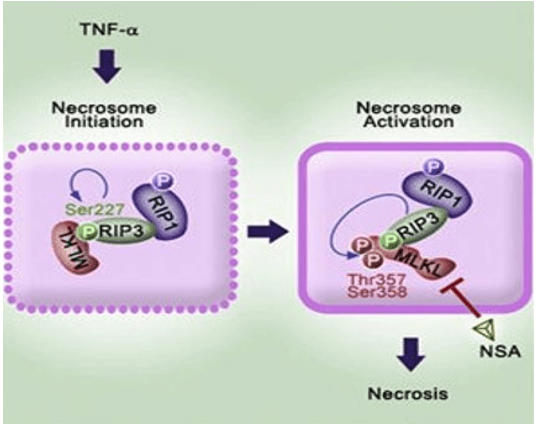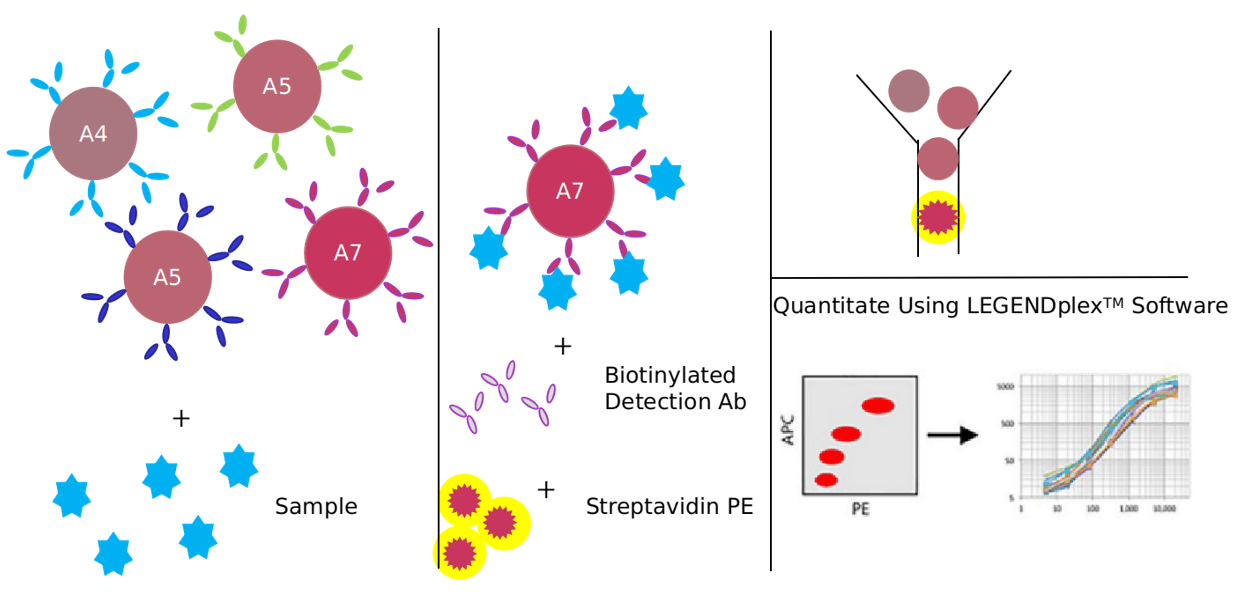TNF-α signaling pathway
Based on Luminex technology platform, Creative Proteomics provides analysis services for key targets of TNF-α signaling pathway.
 (Ren H., et al. 2019)Tumor necrosis factor alpha (TNF-α) plays an important role in inflammation, cell proliferation, differentiation and apoptosis in the immune system as a potent pro-inflammatory cytokine. TNF-α is a type II transmembrane protein that can be expressed in both membrane-bound and secreted forms. the receptor for TNF-α is part of the TNF receptor (TNFR) superfamily and has a characteristic intracellular segment, a transmembrane structural domain and an extracellular extracellular ligand binding domain. They are type I transmembrane glycoproteins characterized by 2-6 repeats of the cysteine motif (up to 40 amino acids) in the extracellular N-terminal structural domain.
(Ren H., et al. 2019)Tumor necrosis factor alpha (TNF-α) plays an important role in inflammation, cell proliferation, differentiation and apoptosis in the immune system as a potent pro-inflammatory cytokine. TNF-α is a type II transmembrane protein that can be expressed in both membrane-bound and secreted forms. the receptor for TNF-α is part of the TNF receptor (TNFR) superfamily and has a characteristic intracellular segment, a transmembrane structural domain and an extracellular extracellular ligand binding domain. They are type I transmembrane glycoproteins characterized by 2-6 repeats of the cysteine motif (up to 40 amino acids) in the extracellular N-terminal structural domain.
TNF-αinitiates apoptotic signaling through 2 surface receptors, TNF-R1 and TNF-R2. The TNF-α trimer is cross-linked to TNF-R1 and this binding leads to the release of SODD and the formation of the TNF-R1 complex consisting of the junctional proteins TRADD, TRAF2, RIP and FADD near the receptor. Tumor necrosis factor-α (TNF-α) is a pleiotropic factor that exhibits antitumor effects, alters endothelial barrier function, reduces tumor mesenchymal pressure and mediates immune responses. TNF-α is associated with a number of cellular signaling events, is associated with cellular necrosis and apoptosis and is important in the fight against infection and cancer.
TNF-α plays a role in apoptosis of mycobacterial-infected macrophages. When alveolar macrophages are infected with a labile or avirulent strain of Mycobacterium tuberculosis, apoptosis proceeds in a TNF-a-dependent manner, and caspase-3 and caspase-9 are involved in the apoptotic process.
Our detectable targets:
| WIPi2 | ATG5 | ATG7 | IPS-1 | NFκB | RIG-1 |
| ATG16 | ATG12 | ATG10 | ISGF3 | UYRAG | TRAF3 |
| TRAF5 | ATG2 | ATG3 | MSK2 | VPS34 | Histone-H3 |
| RIP1 | ATG13 | ATG4 | ISRE | VPS15 | IRF5 |
| p38 | FIP200 | JNK | IRAK1 | TRAF6 | MEK3 |
| AMBRA1 | ULK | MYD88 | Vav | TLR3 | p38MAPK |
| IRF9 | PROLC3 | Rac1 | TBK1 | PKR | SH2 |
| GAS | LC3I | TLR4 | PI3K | mTOR |
Technology platform:
We provide Luminex technology for TNF-α signaling pathway analysis.
Luminex technology is a multifunctional liquid phase analysis platform, which is developed on the basis of high-speed digital signal processing technology, colored microspheres, applied fluidics and laser technology. The core is the use of fluorescent dyes for encoding. By adjusting the different ratios of different fluorescent dyes, more than 100 microspheres with different fluorescence spectra were obtained. The reactions are carried out on microspheres with different fluorescent codes, such as nucleic acid hybridization, antigen-antibody, enzyme-substrate, ligand-receptor binding reactions. Using laser detection technology, qualitative and quantitative analysis of microsphere encoding and reporting fluorescence.
Advantages of TNF-α signaling pathway detection:
- Good repeatability: The Luminex detection platform directly reads the fluorescence value, which is more stable and sensitive: 100 microspheres of each type are detected, and the median value is taken as the result, which is equivalent to 100 repeated detections for each sample.
- Low cost: Simultaneous detection of multiple indicators of a sample can save time, samples, reduce detection costs, and improve analysis efficiency.

Application of our service:
- Study the regulatory mechanism of TNF-α signaling pathway in clinical medicine
- Research on the influence of various medical viruses on TNF-α signaling pathway
- Study the effects of carcinogenic drugs or carcinogenic therapies on TNF-α signaling pathway
Creative Proteomics has developed a signaling pathway target assay platform. We can provide TNF-α signaling pathway assays on one hand, and other signaling pathway assays on the other. In addition, please let us know what other targets you would like to detect and we will customize our services for you. We look forward to working with you.
References:
- Zelová H, et al. TNF-α signalling and inflammation: interactions between old acquaintances. Inflamm Res. 2018, 62(7): 641-651.
- Ren H, et al. Matrix metalloproteinase-mediation of tumor targeting human recombinant tumor necrosis factor-α fusion protein. Mol Med Rep. 2019, 12(2): 2035-2042.



